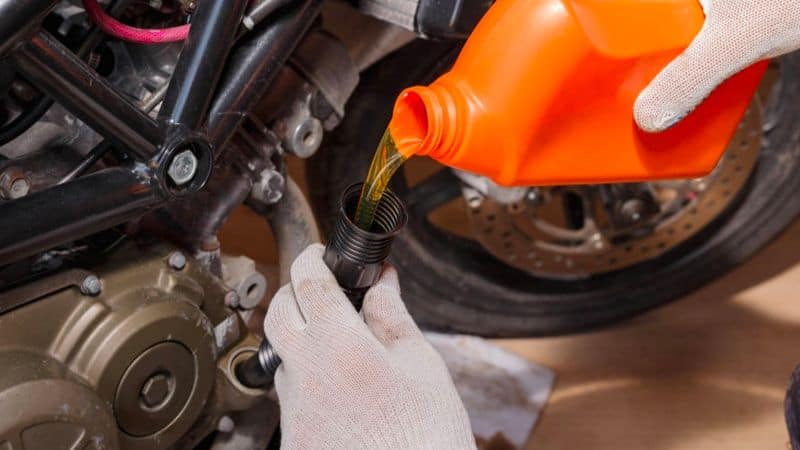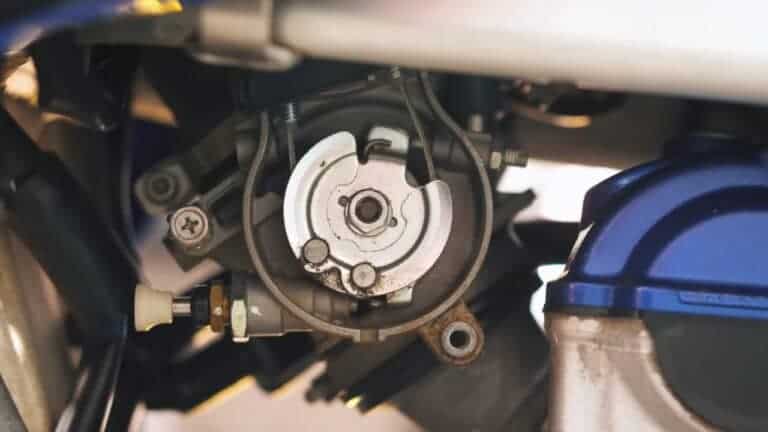How Often To Change Motorcycle Oil? – (Engineer’s Guide)

As an avid motorcycle enthusiast and automobile engineer, I know the importance of engine oil in the motorcycle.
Maintaining the correct engine oil level in any motorcycle is essential to keep it running smoothly. Otherwise, you might face problems in gear shifting and other consequences.
So, how often do you change the engine oil in a motorcycle? It depends on the oil you have used and your motorcycle engine size.
A regular mineral-based motorcycle oil should be changed every 2,000 to 3,000 miles, a semi-synthetic oil should be changed every 5,000 to 6,000 miles, and a fully synthetic engine oil should be changed every 8,000 to 10,000 miles.
If you have a cruiser bike without a radiator, it overheats and evaporates engine oil fast. So, you may need to monitor the level and top-up whenever required.

Table of Contents
- 1 What Is The Role Of Engine Oil In Motorcycles?
- 2 What Are Different Types of Motorcycle Oil?
- 3 What Type Of Engine Oil Is Best For Motorcycles?
- 4 Why Should We Change Motorcycle Oil?
- 5 How Do I Know When My Motorcycle Needs The Oil Changed?
- 6 What Happens If We Don’t Change Motorcycle Oil?
- 7 How To Change Motorcycle Engine Oil At Home?
- 8 How Long Do You Have To Run A Motorcycle Before An Oil Change?
- 9 Conclusion
What Is The Role Of Engine Oil In Motorcycles?
Motorcycle oil lubricates the crankshaft and other moving parts of an engine. Lubrication prevents the bearings from wear and tear. It also prevents your engine from overheating by dissipating heat into the environment.
If no engine oil is used, your motorcycle crankshaft and other parts will wear faster. It will happen because the engine speed is more than 5000 RPM and the extremely high temperatures inside the combustion chamber.
What Are Different Types of Motorcycle Oil?
Three types of engine oil are used in motorcycles: Mineral Oil (conventional oil), Semi-Synthetic Oil, and Fully Synthetic Oil.
- Mineral Oil: It is a petroleum-based oil derived from crude oil and is often used as a lubricant for automobile mechanical components. Mineral oil is a relatively inexpensive option compared to other types of oil, and it provides adequate protection for most small engines.
- Synthetic Oil: Synthetic oil is a motor oil formulated using chemical compounds and additives rather than derived from crude oil like mineral-based oils. This allows synthetic oil to have a more consistent and uniform molecular structure, which results in better performance and protection for your motorcycle engine.
- Semi-Synthetic: Semi-synthetic oil, also known as synthetic blend oil, is a type of motor oil that combines synthetic and mineral-based oils. The blend typically comprises around 30% synthetic and 70% mineral-based oil.
Small engine-size motorcycles (up to 350cc) use conventional mineral-based oil, motorcycles with 350cc to 500cc use semi-synthetic oil, and bigger engine-size motorcycles 600cc or higher use fully-synthetic oil as an engine lubricant.
What Type Of Engine Oil Is Best For Motorcycles?
Most motorcycle manufacturers recommend semi-synthetic and fully-synthetic oil for lubrication. But synthetic oils also come with different viscosity and additives. That’s why motor oil for cars and motorcycles is different and can not be interchanged.
It’s better to refer to your manufacturer’s user manual to know what oil your engine requires. Generally, the bigger engine-size motorcycle uses fully synthetic engine oil for lubrication and cooling.
| Manufacturer | Oil Type | Viscosity Index |
|---|---|---|
| Harley Davidson | Synthetic | SAE 20W-50 |
| Honda | Synthetic | SAE 10W-30 |
| Kawasaki | Synthetic | SAE 10W-40 |
| Yamaha | Synthetic | SAE 10W-40 |
| Suzuki | Synthetic | SAE 10W-40 |
| BMW | Synthetic | SAE 15W-50 |
| Ducati | Synthetic | SAE 15W-50 |
| Triumph | Synthetic | SAE 10W-40 |
| Indian | Synthetic | SAE 15W-60 |
| Royal Enfield | Semi-Synthetic | SAE 15W-50 |
Note– Motorcycle manufacturers use different types of oil for lower engine sizes. So, always check your motorcycle user manual to determine what type of oil your model needs.
Why Should We Change Motorcycle Oil?
The engine oil lubricates the moving parts and helps cool the internal combustion engine. Due to continuous exposure to high temperature, the oil viscosity decrease over time.
Also, the moving parts wear, and metal chips mix with the engine oil. Hence, you should regularly change your engine oil to ensure the proper functioning of your motorcycle.
How Do I Know When My Motorcycle Needs The Oil Changed?
A premium-grade synthetic oil should be changed every 8000 to 10000 miles. However, if you forgot when you changed the oil last time, there are several ways to find out it’s time to change the oil on your motorcycle.
- Dark Smoke From Exhaust: If you notice excessive smoke from your exhaust pipe, your motorcycle probably needs an oil change.
- More Engine Noise: Over time, the oil viscosity reduces due to temperature changes, which fails to lubricate the moving parts. As a result, your engine will be louder than usual. If you notice high engine noise, you should change the motor oil.
- Low Oil Level: All motorcycles have a see-through glass to check the oil level. Your motorcycle will need an oil change if the level is below the minimum.
- Black And Thick Oil: Remove a few drops of engine oil from the dipstick and check its color and consistency. If it’s black and thick, you need to change it immediately.
- Reduced MPG: If your motorcycle is getting less MPG than usual, it’s a sign of bad oil condition, and you should change the engine oil.
What Happens If We Don’t Change Motorcycle Oil?
If you don’t change your motorcycle’s engine oil, it will become thicker and fail to lubricate the moving parts like the crankshaft, connecting rod, piston rings, and clutch.
The friction between these moving parts will increase, and your bike performance will drop.
The improper lubrication will jam the geartrain, and you may face problems in gear shifting. If your motorcycle runs without engine oil, the high temperature will seize the engine.
How To Change Motorcycle Engine Oil At Home?
An engine oil change will cost anywhere between $100 and $150 (depending on the motorcycle and dealer). However, you can change the engine oil yourself and save a lot.
Follow these steps to change your motorcycle engine oil at home-
1. Buy Engine Oil
First, read your motorcycle user manual and find out what oil the manufacturer recommends. Once you know the oil type and viscosity, go to the nearest AutoZone seller or online stores and buy the engine oil.
Click here to check the price of Mobil 1 Full Synthetic Engine Oil on Amazon (Select the Viscosity Grade)
2. Prepare All Tools
You should have an oil container to drain the used fuel, a safety glove, a spanner set and ratchet, and some cotton cloths for cleaning. Once these tools are ready, put your motorcycle on the center stand and idle for 2 minutes.
3. Drain The Oil
You’ll see a few drain plugs at the bottom of the motorcycle’s engine. Put the oil container below that and unscrew all the drain plugs to drain the oil. You may need to tilt the motorcycle to drain used oil from the engine properly.
4. Tighten The Drain Plugs
Once all oil comes from the engine, wipe the drain plug with a cotton cloth and tighten the nuts. Ensure that the drain plugs are securely tightened with the spanner.
5. Fill The New Oil
Remove the dipstick and fill the new oil with the help of a plastic funnel. Ensure that you use the quantity described in the manufacturer’s user manual. Too much engine oil will create problems in gear shifting.
That’s all… You have changed your motorcycle’s engine oil at home. Now, you enjoy a smoother ride.
How Long Do You Have To Run A Motorcycle Before An Oil Change?
You should start your motorcycle and run it for a few minutes to mix up the sitting oil and dust in the engine. This will make the draining easier and remove dust settled in the corners of the engine. It’s recommended to idle your motorcycle for 2 to 3 minutes or ride it for 400 to 600 meters for proper oil draining.
Conclusion
Most of the sportbikes have semi-synthetic and fully-synthetic oil for lubrication. A semi-synthetic oil should be changed every 5000 to 6000 miles, while a fully-synthetic oil should be changed every 8000 to 10000 miles. If you store your bike for winter, change the oil yearly to high performance.





